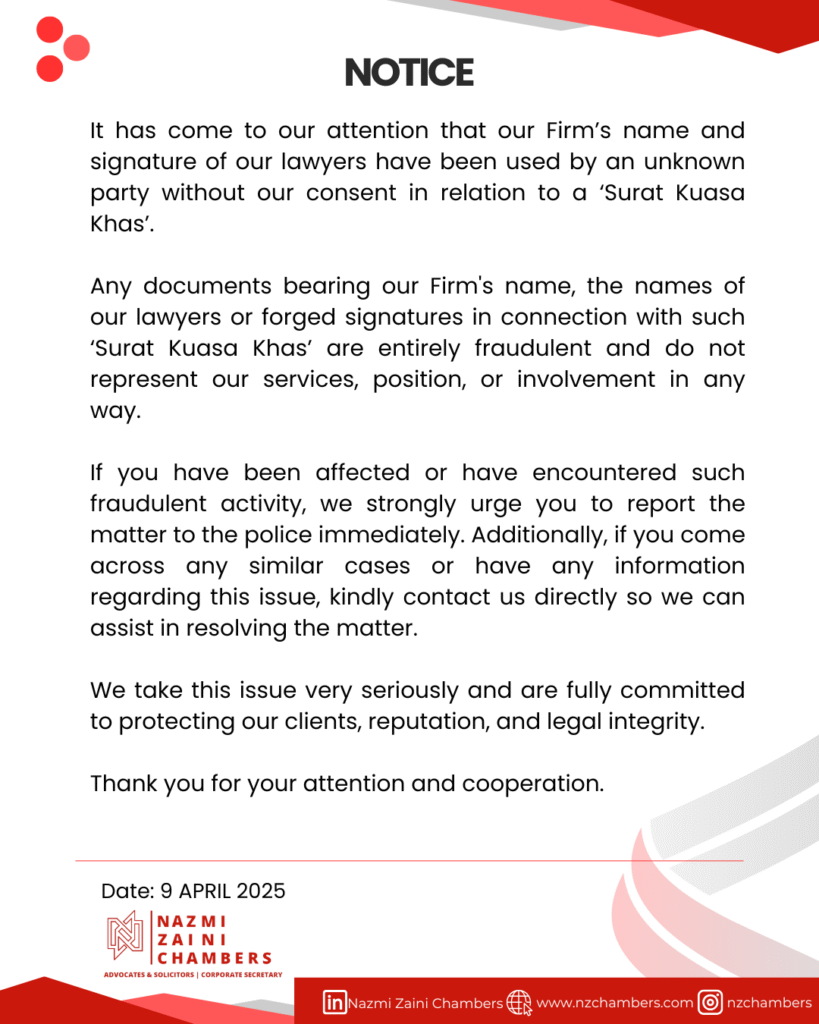Illegal Deposit-Taking: A Legal Perspective on Implications and Recovery for Victims
Understanding Illegal Deposit-Taking
Illegal deposit-taking can be defined as an individual or entity accepting, receiving or managing deposits such as cash or precious metals without the necessary licensing as required by the Financial Services Act 2013 (FSA)[1]. Specifically, Section 137(1)[2] categorises it as a criminal offence for any party to solicit deposits without proper authorisation, particularly from the general public. While there are exceptions, such as security deposits for rentals and payment arrangements under contracts of sale, organisations or individuals accepting deposits in other circumstances may face significant legal repercussions.
Implications of Illegal Deposit-Taking
The consequences for victims of illegal deposit-taking can be severe and varied which include substantial losses, often with limited avenues for recourse due to the lack of regulatory oversight. Additionally, these situations typically lead to emotional distress and a loss of trust in financial institutions. Engaging with unlicensed entities not only increases the risk of financial loss but can also create legal complications for victims, complicating their attempts to recover lost funds.
Guidance for Victims of Illegal Deposit-Taking
We advise clients who find themselves victims of illegal deposit-taking to take immediate and structured action:
- Contact Financial Institutions:
Victims should promptly reach out to their bank or credit card provider to report any suspicious transactions. Financial institutions have measures in place to freeze accounts or reverse unauthorised charges, helping to minimise the impact of the fraud.
- File a Police Report:
It is important to create an official record with law enforcement. Victims should file a detailed report to document the illegal activity and provide authorities with the necessary information to conduct a thorough investigation.
- Report to Regulatory Bodies:
Victims should notify regulatory authorities, such as Bank Negara Malaysia, about the incident. Submitting a detailed complaint ensures that these agencies are aware of the situation and can take appropriate action against the perpetrators.
- Engage Relevant Enforcement Agencies:
In addition to reporting to regulatory bodies, victims should approach appropriate enforcement agencies to assist with further investigation. This step is crucial for gathering evidence and possibly pursuing legal action against those responsible for the fraud.
Legal Remedies Available to Victims
Victims of illegal deposit-taking have several avenues for legal recourse, including claims of fraudulent misrepresentation. These claims hinge on the premise that false statements led to reliance on misleading information, resulting in financial loss. Additionally, victims may pursue actions under the tort of conversion, civil fraud, or initiate a civil suit for restitution on grounds of unjust enrichment. The appropriate legal strategy will depend on the specific circumstances of each case.
The principles of fraudulent misrepresentation are illustrated in the case of ALW Carworkshop Sdn Bhd v AXA Affin General Insurance Bhd[3], which underscores the need to establish the following elements:
- A false representation was made.
- The party making the representation knew it was false or acted recklessly regarding its truth.
- The victim relied on the false representation.
- The victim acted based on that reliance.
- The victim suffered losses directly resulting from this reliance.
Courts have consistently recognised victims’ entitlement to compensation for actual losses stemming from fraudulent activities, including consequential damages linked to asset acquisition.
Alternatively, the courts may order the forfeiture of illegal deposits to prevent offenders from benefiting from their crimes. Illegal deposit-taking is prohibited under the Anti-Money Laundering, Anti-Terrorism Financing and Proceeds of Unlawful Activities Act 2001 (AMLATFPUAA). Section 56(2)(a)(iii)[4] mandates the forfeiture of property connected to offences such as terrorism financing and other unlawful activities.
In Noor Ismahanum Mohd Ismail v PP[5], the court held that funds in two bank accounts likely originated from illegal deposit-taking activities under the AMLATFPUAA. The presiding judge ordered the forfeiture of these funds based on a “more probable than not” connection to unlawful activities. The appellant’s lack of a valid licence to accept deposits constitutes a breach of Section 25(1) of the Banking and Financial Institutions Act 1989 (BAFIA)[6], further supported this finding. The Judicial Commissioner dismissed claims of ignorance regarding transactions in the CIMB account due to insufficient evidence, and arguments that funds in the CIMB and MBB accounts were from legitimate sources were similarly rejected.
In Sarwan Singh a/l Kundan Singh v Aminah binti Faudzar[7], the plaintiff challenged a High Court judgement on three grounds:
- The deposits contravened Sections 137 and 136 of the FSA[8].
- The judgment was rendered without proper jurisdiction.
- The defendant obtained the judgment fraudulently.
The plaintiff argued that the defendant misrepresented the deposits as investment transactions to circumvent legal restrictions. The court affirmed the plaintiff’s right to challenge the transactions’ legality if evidence of fraud or illegality was provided. This decision reinforces the principle that procedural defences do not shield illegal transactions, enabling victims to recover their losses.
Forfeiture under Section 56 of the AMLATFPUAA[9] facilitates the recovery of funds linked to illegal deposit-taking by focusing on the proceeds of unlawful activities. Courts may seize assets proven to be connected to illegal activities, regardless of whether the asset holder is criminally liable. However, recipients acting in good faith without knowledge of the illegality may not be required to return the funds. This mechanism provides an avenue for addressing harm inflicted on victims, even in cases where direct compensation is not pursued, as seen in PP v Habib Jewels Sdn Bhd[10].
In MEL v LMK & Anor[11], the court’s recognition of unlawful conversion serves as a precedent for victims to claim damages for wrongfully transferred funds. The case involved a plaintiff converting over RM1 million from accounts belonging to her husband and mother-in-law, demonstrating the potential for recovery through conversion claims.
Similarly, Sinnaiyah & Sons Sdn Bhd v Damai Setia Sdn Bhd[12] outlines key principles regarding the burden of proof in civil fraud claims. This case provides guidance on the legal standards victims must meet to substantiate their claims and reclaim misappropriated funds.
Finally, in Munisamy a/l Rajagopal v Subashini a/p Karuppiah[13], the court recognised restitution for unjust enrichment, offering another remedy for victims. By proving that funds were unjustly retained, victims can seek recovery under Section 71 of the Contracts Act 1950[14], highlighting the equitable relief available to them.
Pursuing Claims Against Financial Institutions
When financial institutions fail to exercise due diligence, thereby enabling scams, victims may have valid grounds for legal claims against the bank. Financial institutions are required to implement reasonable safeguards to prevent fraudulent activities, as outlined in guidelines such as “Know Your Client” and “Anti-Money Laundering” protocols.
The case of Perwira Habib Bank (M) Bhd v. Wong Keng Fatt[15] exemplifies circumstances under which banks can be held liable for a lack of reasonable skill and care, highlighting the importance of their proactive responsibilities to clients.
Conclusion
Illegal deposit-taking presents significant financial and emotional challenges for victims, underscoring the critical need for awareness, prompt action, and strategic legal recourse. By understanding their rights and the available remedies whether through claims of fraudulent misrepresentation, conversion, civil fraud, or unjust enrichment, victims can pursue justice and recover their losses. The legal precedents and statutory frameworks discussed illustrate the judiciary’s commitment to protecting victims and addressing the consequences of unlawful financial practices.
At the same time, this issue highlights the importance of robust regulatory compliance and due diligence by financial institutions to prevent such activities. Victims should not hesitate to leverage the support of legal professionals to navigate these complex processes, ensuring their interests are effectively represented. With the right approach, victims can hold offenders accountable, recover misappropriated assets, and contribute to a safer and more transparent financial system.
If you have any questions or queries, please contact our Advisory & Compliance Partner, Mr. Afif Che Had (afif@nzchambers.com).
Author: Afif Che Had
References:
[1] Financial Services Act 2013 [Act 758]
[2] Section 137(1) of the Financial Services Act 2013 [Act 758]
[3] [2019] MLJU 567
[4] Section 56(2)(a)(iii) of the Anti-Terrorism Financing and Proceeds of Unlawful Activities Act 2001
[5] [2019] 2 MLJ 536
[6] Section 25(1) of the Banking and Financial Institutions Act 1989
[7] [2020] MLJU 1230
[8] Sections 137 and 136 of the Financial Services Act 2013
[9] Section 56 of the Anti-Terrorism Financing and Proceeds of Unlawful Activities Act 2001
[10] [2020] 12 MLJ 757
[11] [2023] 12 MLJ 655
[12] [2015] 5 MLJ 1
[13] [2023] 8 MLJ 406
[14] Section 71 of the Contracts Act 1950
[15] [2014] MLJU 1822 [HC]





